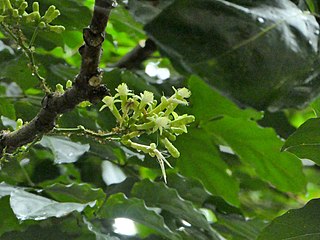Archidendron vaillantii
| Salmon bean | |
|---|---|

| |
| Ripened fruit and foliage | |
| Scientific classification | |
| Kingdom: | Plantae |
| Clade: | Tracheophytes |
| Clade: | Angiosperms |
| Clade: | Eudicots |
| Clade: | Rosids |
| Order: | Fabales |
| Family: | Fabaceae |
| Subfamily: | Caesalpinioideae |
| Clade: | Mimosoid clade |
| Genus: | Archidendron |
| Species: | A. vaillantii
|
| Binomial name | |
| Archidendron vaillantii | |
| Synonyms[4] | |
|
Homotypic synonyms
Heterotypic synonyms
| |
Archidendron vaillantii, commonly known as the salmon bean, is an evergreen tree in the legume family Fabaceae. It is endemic to the rainforests of northeast Queensland.
Description[edit]
Archidendron vaillantii is a tree growing up to 25 m (82 ft) high and a DBH up to 30 cm (12 in).[5][6] The large evenly bipinnate leaves are around 60 cm (24 in) wide and long with usually 2 pairs of leaflets or pinnae, which in turn are further divided into 2-4 pairs of subleaflets or pinnules (see Gallery). The subleaflets are dark glossy green, elliptic to orbicular and slightly asymmetric, measuring up to 20 by 11 cm (7.9 by 4.3 in), and have very short petioles.[5][6]
The inflorescences are axillary or terminal panicles, each a cluster of 4–8 flowers on pedicels about 5 mm (0.20 in) long. Flowers are yellowish, the calyx greenish, up to 35 mm (1.4 in) long with 5 petals.[6][7]
The fruit is a twisted or tightly coiled dehiscent pod, red on the outside and yellow inside, up to 135 mm (5.3 in) long by 15 mm (0.59 in) wide, containing a number of glossy black seeds about 10–15 mm (0.39–0.59 in) long.[6][7]
Taxonomy[edit]
This species was first described in April 1865 by the German born Victorian Government botanist Ferdinand von Mueller, who published a description in his tome Fragmenta phytographiæ Australiæ. His description was based on material collected by John Dallachy in the Seaview Range west of Ingham.[5][8]: 9 Mueller revised his description later in the same year and transferred the species to Archidendron.[8]: 60
The taxon was reviewed twice more — first by Carl Ernst Otto Kuntze in 1891, giving it the combination Affonsea vailantii, and then by Alfred James Ewart in 1907 who described a subspecies Albizia vaillantii var. pentzkeana, however neither of these names are now accepted.[4]
Etymology[edit]
The genus name Archidendron is a combination of the Latin prefix archi- meaning "main", "chief" or "leading", and the Ancient Greek word δένδρον (déndron), meaning "tree".[7] The species epithet vaillantii was given by Mueller in honour of the marshall of France, Jean-Baptiste Philibert Vaillant.[8]: 10
Distribution and habitat[edit]
The salmon bean is restricted to the coastal area from about Rossville south to the Paluma Range National Park. It grows in rainforest on various soils at altitudes from sea level to 1,200 m (3,900 ft).[5][6][7]
Conservation[edit]
This species, which is endemic to Queensland, has been classified by the Queensland Department of Environment and Science (DES) as least concern, but DES provides no explanation as to the process of, or the reason for, this assessment.[1]
In September 2010 the International Union for Conservation of Nature (IUCN) assessed it as near threatened. The justification for this assessment published by IUCN cites the reduction of the species' natural habitat, and the existence of the pathogen Phytophthora cinnamomi within its range.[2]
Gallery[edit]
-
The compound leaf
-
Foliage
-
Flowers
-
Tree
-
Fruit
-
Fruit with a standard 30 cm/12in ruler
-
Trunk
-
Sunken gland on the rachis, an identification feature
References[edit]
- ^ a b "Species profile—Archidendron vaillantii". Queensland Department of Environment and Science. Queensland Government. 2022. Retrieved 6 February 2023.
- ^ a b Malcolm, P. (2012). "Archidendron vaillantii". IUCN Red List of Threatened Species. 2012: e.T19892912A20007197. doi:10.2305/IUCN.UK.2012.RLTS.T19892912A20007197.en. Retrieved 6 February 2023.
- ^ "Archidendron vaillantii". Australian Plant Name Index (APNI). Centre for Plant Biodiversity Research, Australian Government. Retrieved 6 February 2023.
- ^ a b c "Archidendron vaillantii (F.Muell.) F.Muell.". Plants of the World Online. Royal Botanic Gardens, Kew. Retrieved 6 February 2023.
- ^ a b c d F.A.Zich; B.P.M.Hyland; T.Whiffen; R.A.Kerrigan (2020). "Archidendron vaillantii". Australian Tropical Rainforest Plants Edition 8 (RFK8). Centre for Australian National Biodiversity Research (CANBR), Australian Government. Retrieved 9 February 2023.
- ^ a b c d e Cowan, R.S. (2022). "Archidendron vaillantii". Flora of Australia. Australian Biological Resources Study, Department of Climate Change, the Environment and Water: Canberra. Retrieved 9 February 2023.
- ^ a b c d Cooper, Wendy; Cooper, William T. (June 2004). Fruits of the Australian Tropical Rainforest. Clifton Hill, Victoria, Australia: Nokomis Editions. p. 310. ISBN 9780958174213.
- ^ a b c Mueller, Ferdinand von (1865). Fragmenta phytographiæ Australiæ. Vol. 5. Melbourne: Joannis Ferres. Retrieved 4 June 2023.
External links[edit]
 Data related to Archidendron vaillantii at Wikispecies
Data related to Archidendron vaillantii at Wikispecies Media related to Archidendron vaillantii at Wikimedia Commons
Media related to Archidendron vaillantii at Wikimedia Commons- View a map of historical sightings of this species at the Australasian Virtual Herbarium
- View observations of this species on iNaturalist
- View images of this species on Flickriver









